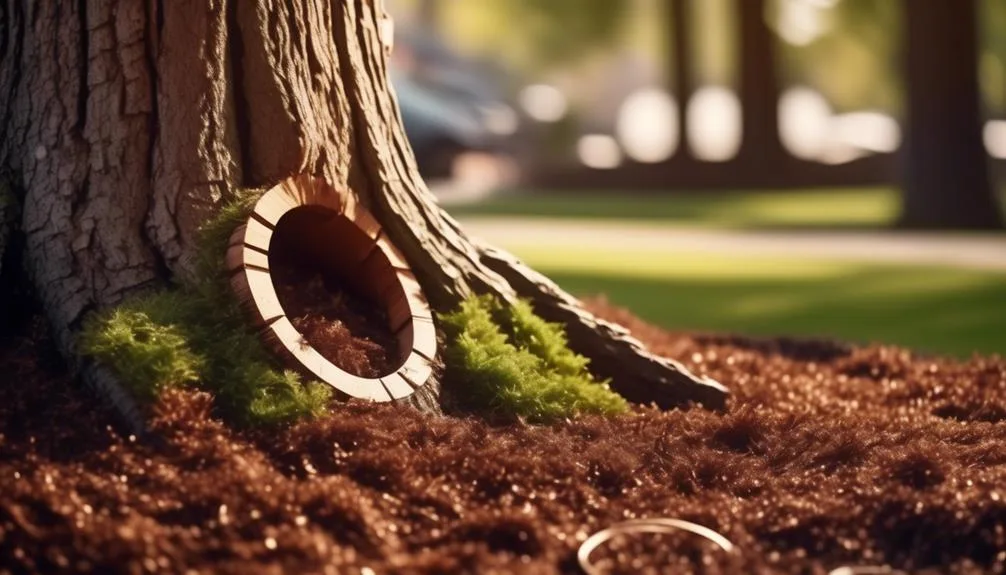Mulching around cedar trees is crucial for their health and appearance, but it can be tricky. With the right approach, you can ensure your cedar trees thrive in a well-mulched environment.
This discussion covers selecting the proper mulch material and avoiding common mistakes, equipping you with the knowledge to mulch around cedar trees the correct way.
Let's start by exploring the crucial first step: selecting the right mulch material.
Selecting the Right Mulch Material
How do you choose the best mulch material to protect and nourish your cedar trees?
When it comes to mulching around cedar trees, it's important to select the right material.
Organic mulches like wood chips, bark, or pine straw are excellent choices. They decompose over time, adding nutrients to the soil and promoting a healthy environment for your cedars.
Inorganic mulches such as gravel or stones can also be used, especially in areas where you want to prevent weed growth. They don't break down like organic mulches, so they provide longer-lasting protection.
Whether you opt for organic or inorganic mulch, ensure it's spread evenly around the base of the trees, leaving a small gap between the mulch and the tree trunk to prevent moisture-related issues.
Determining the Optimal Mulch Depth
To determine the optimal mulch depth for your cedar trees, start by considering the specific needs of your trees and the surrounding environment. Mulch benefits include moisture retention, weed suppression, and temperature regulation.
For cedar trees, a 2-3 inch layer of mulch is generally recommended. However, in areas with hot, dry climates, a thicker layer of 4 inches may be more suitable to help retain moisture. On the other hand, in cooler, wetter climates, a thinner layer of 1-2 inches may be preferable to prevent excessive moisture retention.
Keep in mind that mulch alternatives such as pine straw or wood chips can also affect the optimal depth needed. Ultimately, the optimal mulch depth for your cedar trees will depend on factors such as climate, soil type, and the specific needs of your trees.
Applying Mulch Correctly
When it comes to applying mulch correctly around cedar trees, the optimal depth determined based on your trees' specific needs and the surrounding environment is crucial for promoting their health and growth. Proper mulching techniques play a significant role in maintaining the well-being of your cedar trees.
Here are some essential tips for mulch application:
- Avoid Piling Up Against the Trunk: Leave a gap of a few inches around the base of the tree to prevent moisture buildup and potential rot.
- Spread Evenly: Apply the mulch evenly around the tree, ensuring it extends out to the drip line to cover the entire root zone.
- Maintain the Right Depth: Aim for a depth of 2-4 inches, ensuring enough coverage without suffocating the roots.
- Use Organic Mulch: Opt for organic materials like wood chips or bark to provide essential nutrients as they decompose.
Avoiding Common Mulching Mistakes
To maintain the health of your cedar trees and avoid common mulching mistakes, it's essential to pay attention to the quality and quantity of mulch applied around the tree. Proper mulching offers various benefits such as moisture retention, weed suppression, and insulation from temperature extremes. However, incorrect mulching techniques can lead to detrimental effects on tree health. Here are some common mulching mistakes to avoid:
| Common Mulching Mistakes | How to Avoid Them |
|---|---|
| Excessive Mulch | Keep mulch depth to 2-4 inches and away from the tree trunk. |
| Volcano Mulching | Spread mulch in a flat layer, resembling a doughnut, not a volcano. |
| Ignoring Mulch Quality | Use organic mulch that decomposes to improve soil quality. |
Maintaining Mulch Around Cedar Trees
You can maintain the health and vitality of your cedar trees by regularly checking and adjusting the mulch around the base of the trees.
Here are some essential tips for maintaining mulch around cedar trees:
- Check Moisture Levels: Ensure that the mulch isn't causing excessive moisture retention around the base of the cedar trees.
- Adjust Thickness: Periodically assess the thickness of the mulch layer and add more if it has decomposed significantly.
- Inspect for Decay: Regularly inspect the mulch for signs of decay or mold, and remove any affected areas promptly.
- Avoid Piling Against Trunk: Make sure the mulch isn't piled up against the trunk of the cedar tree, as this can lead to moisture-related issues and potential pest problems.
Following these maintenance practices will contribute to the overall health and longevity of your cedar trees, enhancing their beauty and resilience.
Conclusion
Incorporating proper mulching practices for cedar trees safeguards their well-being and enhances your landscape. Selecting the right mulch, applying it at the correct depth, and avoiding common mistakes are key to maintaining the health of your trees.
By doing so, you not only protect your cedars but also elevate the aesthetic appeal of your outdoor space. Take care of your mulch, and your cedars will flourish.

My interest in trees started when I first saw the giant sequoias in Yosemite.
I was a teenager then, and I remember thinking, “I need to learn more about this.”
That moment stuck with me.
A few years later, I went on to study forestry at Michigan Tech.
Since graduating, I’ve worked in a mix of hands-on tree care and community education.
I’ve spent over ten years helping people understand how to plant, maintain, and protect the trees in their neighborhoods.
I don’t see trees as just part of the landscape.
They are living things that make a real difference in our daily lives.
